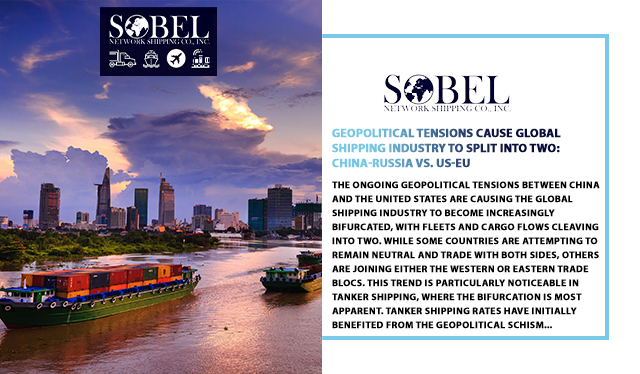The ongoing geopolitical tensions between China and the United States are causing the global shipping industry to become increasingly bifurcated, with fleets and cargo flows cleaving into two. While some countries are attempting to remain neutral and trade with both sides, others are joining either the Western or Eastern trade blocs. This trend is particularly noticeable in tanker shipping, where the bifurcation is most apparent. Tanker shipping rates have initially benefited from the geopolitical schism, as the post-invasion trading pattern is far less efficient than the pre-war pattern, significantly boosting tanker ton-miles, a plus for freight rates.
The same distance effect has been seen previously after sanctions against Iran and Venezuela, which shifted their crude exports onto longer routes to China. Geopolitics has also caused a bifurcation in the tanker fleet, with two sides emerging: tankers transacting in US dollars and using Western insurance and finance providers, and vessels with opaque ownership that do not transact in dollars and do not use Western services.
The geopolitical unrest poses downside risks to tanker demand, as a shift to geopolitical rivalry as opposed to multilateral cooperation would translate into a 6.4% GDP hit for developed countries through 2050, a 10.2% GDP loss for developing countries, and an 11.3% GDP blow to the least developed countries. Moreover, an escalation of the Ukraine-Russia war or a military conflict involving the US and China over Taiwan is predicted to have a highly negative effect on the global economy, tanker demand, and tanker stocks.
In container shipping, the focus is on “friend-shoring” – container trade between trusted countries that share common values. If friend-shoring becomes the standard trading model, ocean carriers will need to start thinking creatively about how they can continue to serve both sides of the divide. Container shipping is more exposed than tanker shipping to global GDP, which economists argue will be negatively affected by geopolitical rivalry versus multilateral cooperation. A war involving China would be as extreme or more extreme for container shipping than for tanker shipping.
The dry bulk shipping market is also bifurcating. Trade has become less efficient, with bulker ships sailing longer distances and not loading non-Russian cargoes on backhaul legs, leading to less triangulation, higher ballast time, and lower utilization. While this trend is initially positive for rates, in the longer term, dry bulk demand is heavily driven by global GDP and the Chinese economy in particular, both of which would theoretically suffer under a “geopolitical rivalry” trade scenario.
Cargo flows and shipping fleets are on a path toward fragmentation. As the World Trade Organization warned in its new world trade outlook, released Wednesday, “Fragmentation … remains a significant threat, which could hinder economic growth and reduce living standards over the long term.”


